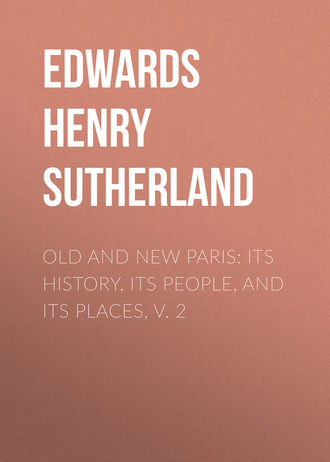 полная версия
полная версияOld and New Paris: Its History, Its People, and Its Places, v. 2
Apart from the purely spontaneous, impulsive movement, meetings were held after formal deliberations, and it was decided by a resolution that the aristocrats and priests confined in the prisons must be put to death.
To return, however, to Bicêtre, which is associated in more than one way with the Revolution and with the Reign of Terror. In a little courtyard adjoining the amphitheatre of Bicêtre, on the 15th of April, 1792, was tried for the first time on a corpse (previous experiments had been made with live animals) the “decapitating machine,” whose invention, wrongly attributed to Dr. Guillotin, belongs really to Dr. Louis, perpetual secretary of the Royal Society of Surgery: whence the name of “Louisette” given in the first instance to the guillotine.
Some time afterwards, towards the end of 1792, Bicêtre, which had just been the theatre of such tragic scenes, had the glory of seeing accomplished within its walls the reforms in the treatment of lunacy introduced by Pinel. This excellent man, chief physician at Bicêtre, had begged the Commune of Paris for authority to unchain the violent lunatics. The next day the fanatical Couthon went to Bicêtre to make sure that Pinel was “not concealing the enemies of the people among his madmen.” Astounded and somewhat frightened by the confused shrieking and howling of the maniacs, and by the rattling of their chains, the surly Jacobin turned to Pinel and said to him “Why, you must be mad yourself, citizen, to think of unchaining such animals.”
“I am convinced,” replied Pinel, “that these lunatics are only so intractable because they are deprived of air and liberty.”
“Well, do what you like,” cried Couthon, as he went away; “do what you like: I abandon them to you.”
Pinel at once entered the cage of the most terrible of his madmen: an English captain who had been shut up for forty years, and who, a few days previously, had killed one of the keepers with a blow from his fetters. Full of faith, the physician unlocked his irons; and the madman becoming at once gentle and calm, was, during the two years he had still to live, Pinel’s most useful assistant. Pinel restored successively to liberty an old officer who, in a moment of frenzy, had stabbed one of his own children; a young poet mad from love, who, after leaving Bicêtre, perished on the scaffold; a soldier formerly in the Royal Guard; Chevingé, an athlete, the terror of his keepers, who soon afterwards gave his liberator a striking proof of gratitude by snatching him from a band of fanatics at the very moment when they were about to hang him; and fifty others, of all conditions and all countries, who, as soon as they were treated with humanity, gave up their habits of violence.
Finally, it may be mentioned that in the old dungeons of Bicêtre Victor Hugo lays the scene of his “Dernier Jour d’un Condamné.”
It has been seen that neither at Bicêtre nor at La Salpêtrière are lunatics alone confined. The one recognised madhouse in or near Paris, to which those whose ideas or actions excite the disapproval of their friends are told familiarly to go – as, in England, they would be sent to Hanwell – is Charenton. The Maison de Charenton, situated at about four miles south-east of Paris, on the road to Lyons, close to the confluence of the Seine and the Marne, dates from the year 1641, when Sebastien Leblanc, counsellor of the king and minister of war, presented it ready furnished to the brothers of La Charité, or of St. Jean de Dieu. A few years after their installation in the house presented to them, the brothers of La Charité arranged to receive madmen and epileptic patients; when, like all the madhouses of the time, Charenton became a house of detention, where were confined by lettres de cachet prisoners of state, prodigals, libertines, and others who were thought worthy of a milder treatment than they would receive in the Bastille or at Vincennes. In the eighteenth century, and up to the time of the Revolution, Charenton had accommodation for nearly 100 lunatics, each of whom had his separate room. The attendance was in the hands of ten religious persons and fifty-two servants. A few years after the Revolution, both monastery and hospital were suppressed, and the monks, together with the lunatics under their charge, dispersed. Soon afterwards, however, the Directory issued a decree, which forms the legal basis of the hospital of Charenton as it now exists. “Refuge for the Mad” was the title given to it; and it was now placed under the immediate direction of the Minister of the Interior. Insane persons of both sexes were to be admitted; the indigent ones gratuitously, and others at a fixed rate of payment. The Abbé de Coulmier, a former member of the Constituent Assembly, was named director of the establishment; and, as if in compensation for the injury done to the establishment by its sudden dispersion, it had additional land assigned to it. The building could now be enlarged, and a special division was erected for the women.
M. de Coulmier conducted the house in the most despotic manner; and on the death of the principal surgeon, M. Gastaldi, in 1805, he assumed such powers in the medical department that the School of Medicine was obliged to intervene, when the medical direction was placed in the hands of Dr. Royer-Collard, brother of the celebrated orator of the same name. With all his tyranny, M. de Coulmier had many agreeable ways. Remembering the fury of Saul, calmed by the harp of the youthful David, and the quieting of savage animals by the lyre of Orpheus, the director, carried away by his artistic feeling, determined to apply a similar treatment to the demented ones of Charenton. To carry out his idea he introduced dancing, dramatic performances, fireworks, and even ballets, with the assistance of some of the choregraphic celebrities of the epoch. The imprisoned Marquis de Sade, known by books that no decent person can read, was the organiser of these entertainments, which were attended by all Paris.
To the joyous reign of M. de Coulmier succeeded, in 1814, the severe administration of Roulhac du Maupas. No more singing and dancing now! Comedies and ballets gave place to useful reforms, and the substitution of a new medical organisation for the former choregraphic system. Royer-Collard had suppressed the iron girdles, the fetters, the handcuffs, and the collars, by which the ungovernable madmen used to be restrained, and the melancholy ones driven to suicide. Esquirol did away with the human figures in wicker-work, in which violent maniacs used sometimes to be enclosed. The new programme met with the full approbation of the Government. A credit of 2,720,000 francs was voted by the Chamber of Deputies in July, 1838; and soon afterwards M. de Montalivet, then Minister of the Interior, laid with due solemnity the first stone of the new edifice. The memory of this important ceremony is consecrated by an inscription placed beneath the vestibule of the principal building.
At the back of the building is the wood of Vincennes, from which it is separated only by a wall, with a gate for the inmates of the asylum. In front the landscape comprises the immense and fertile plain of Maisons Alfort, Ivry, and Choisy-le-Roi. The panorama is one of the finest offered by the environs of Paris. The capricious meanderings of the Marne, with its green banks and its flower-clad islands, the picturesque hill of Alfort, the interesting domain of Charentonneau; villages sparkling beneath the sun in the midst of fields and meadows: on the horizon the smiling slopes of Saint-Maur, Créteil, Champigny, Chenevières, and Boissy-Saint-Lèger; the forest of Sénart, Villeneuve-St. – Georges – which, deserted by its inhabitants, was occupied, during the last war, in every house and every room by German troops, who left behind them sad proofs of their destructiveness; and, finally, the majestic course of the Seine, and its union with the Marne. The new establishment has been so built that from nearly every room the patients can gladden their eyes and refresh their minds by contemplating the enchanting scenery.
The patients are grouped together, not with reference to their social rank, but according to the medical peculiarities of each particular case. In the first division are patients who have reached the convalescent stage, and who are quiet. In the second are the lunatics who know how to behave themselves, but are still subject to fits of insanity. The third class consists of incurable lunatics, who are nevertheless capable of obeying orders. The fourth is reserved for incurable lunatics, difficult to govern; the fifth for paralytic lunatics; the sixth for lunatics who have been attacked by some ordinary malady; the seventh for epileptic patients; and the eighth for violent uncontrolable maniacs.
During the last twenty or thirty years a hydropathic establishment has been added to the asylum, together with workshops for the occupation and amusement of the convalescent.
On the 2nd of February, 1866, the Empress paid a visit to Charenton, and took the institution under her special patronage. She began by proposing the construction of a department for women on the same system and the same scale as the well-organised department for men; and, adopting the Empress’s idea, the legislative body voted an important sum towards carrying it out.
Charenton receives about 600 patients, 300 men and 300 women; but the number would be much larger were there sufficient accommodation. The terms for the paying patients are 1,500 francs for the first class, 1,200 for the second, and 900 for the third, while for those who have a separate room 900 francs extra, as the wages of a servant, are charged. Needless to add that the patients, paying or non-paying, are all on an equality as regards medical treatment. The quality and variety of the cooking vary with the different classes. The chief elements of the population of Charenton are furnished by officials and clerks, artists and men of letters, merchants, dealers in wine and spirits, officers and soldiers. Every type of madness may there be studied, from dementia and melancholia to mania. Many of the patients owe their malady to hereditary predisposition, alcoholic excesses, and other abuses, domestic calamities, reverses of fortune, and intellectual labour unduly prolonged.
Nothing is spared to provide the patients with salutary occupations, agreeable pastimes, and innocent amusements. They are encouraged to study music, singing, and drawing, and for those who have no artistic tastes, cards, draughts, dominoes, billiards, and bowls are provided. Among the outdoor recreations walks in the most beautiful parts of the wood of Vincennes, carriage excursions and picnics may be mentioned. The Thursday and Sunday concerts form, however, the great delight of the place. These are not given by the director simply as entertainments. They are prescribed by the regulations, and have formed part of the institutions of the House since 1811. In the spacious hall, which serves at once as ball-room and concert-room, assemble upwards of a hundred convalescents of both sexes. In the dress and demeanour of those present there is nothing remarkable, except that they are more quietly attired, and generally better behaved than in fashionable society. The billiard-room is much frequented, and the general aspect of the card-room reminds Dr. Linas of one of the aristocratic Paris clubs.
It should have been mentioned that at the periodical concerts the music is contributed by the patients, some of whom are singers, others violinists or pianists. The officials of the establishment join the inmates either as performers or among the audience. In like manner the patients and attendants act together in the comedies and dramas which are sometimes represented.
Charenton, though placed under the direction of the Ministry of the Interior, has its own particular administration, in which a clerk may in due time, after successive promotions, rise to be a functionary of almost the first rank. No one voluntarily quits the establishment; and the servants, like the officials, remain there until they are compelled by old age to resign. Charenton, like other madhouses, has had celebrities among its inmates, including the Marquis de Sade, who, after sending one of his infamous books to Napoleon, was at once ordered to be arrested and placed in a lunatic asylum; the same punishment which, at a later date, was inflicted by the Emperor Nicholas on a writer, blameless in his morality, who had attacked the existing order of things in Russia.
CHAPTER XXX.
THE RIVER BIÈVRE AND THE MANUFACTORY OF THE GOBELINS
The Brothers Gobelin – Lebrun – The Gobelins under Louis XIV. – At the Time of the Revolution – The Manufactory of SèvresTHE Bièvre is a stream which, many years ago, behaved so badly in the matter of inundations that it was put under ground. Canalised subterraneously, it runs beneath or by the side of the Horse Market, passes near the Salpêtrière, and enters the Seine close to the Orleans Railway terminus. It is between the Bièvre and the Rue Mouffetard that the buildings of the Gobelins manufactory, so famed for its tapestry and dyes, are situated.
The superiority of the products of this factory is by some attributed to peculiar saline properties in the stream. Of these Rabelais speaks in thoroughly Rabelaisian style; and it was doubtless in consequence of the tinctorial qualities of the river that the brothers Gobelin established on its banks their famous manufactory.
It is to these brothers that the name of the establishment is due. They were famous dyers in Normandy, or, as is also said, at Rheims, in Champagne; and, whatever their origin, they came to Paris in the middle of the fifteenth century, and took up their position on the banks of the river above mentioned.
The water of the Bièvre, while helping the development of Gobelin dyes, is injured by them. Like all the streams which flow past dye works, the Bièvre is perpetually stained; and in the present day there are many scientific men who venture to affirm that the brilliant colours of the Gobelin tapestry are in no way due to water of any kind, but to artistic secrets belonging to the Gobelin brothers, and handed down by them to their descendants or successors.
Under the reign of Louis XIV. the Gobelins was a sort of school of furniture, in which not only tapestry but cabinet work of every kind was cultivated. “Here,” writes a chronicler of the time, “two hundred and fifty master weavers produced the richest tapestries, after the works of our best painters. The school was extended in order to include sculptors in metal and goldsmiths.”
A passion for ornamentation now took possession at once of the Court and of Paris society generally; and the candelabra and the lamps produced at the Gobelins were worthy of any palace. Most of the works produced at the Gobelins, to whatever category they belonged, were intended as presents to members of royal families and other persons of the very first distinction. Among the painters attached to the Gobelins manufactory may, in the first place, be mentioned the celebrated Lebrun in the reign of Louis XIV., and under the government of Colbert. “And as a matter of fact,” says an historian, “Lebrun gave to the Gobelins a splendour which was steadily maintained.”
He painted for the manufactory, simply that they might be reproduced in wool, some of his greatest pictures, including “The Battles of Alexander,” “The History of Louis XIV.,” “The Twelve Months of the Year,” “The Story of Moses,” etc. etc. Van der Meulen, Yvart, Boëls, and others may be mentioned among the painters attached permanently to the establishment.
When, on the death of Lebrun, Mignard succeeded him as Director of the Gobelins, an architect, La Chapelle-Bessé, was appointed architect and builder. Under the joint direction of painter and architect a school of drawing was created at the Gobelins with Toby, Coysevox, and Sebastien Leclerc as professors.
Unfortunately the reverses sustained by Louis XIV. during the last year of his reign led to the discharge of the best workmen at the Gobelins, whom it was thought impossible any longer to pay; and from this time the establishment has occupied itself only with the production of tapestry, to the neglect of medals, cameos, cabinet work, and artistic furniture generally.
Specimens of the Gobelin tapestry were often given away as presents either to crowned heads or to celebrities of less eminence whom the king wished to honour with some mark of distinction. Thus there may still be seen at Windsor Castle the tapestries of “Esther” and of “Jason and Medea,” given to the King of England by Louis XIV. The King of Siam, the Emperor of Russia, the Duke of Lorraine, and the King of Prussia received similar presents. Occasionally, too, the Gobelins executed orders for men of wealth and of high position; and in every country in Europe so rare a work of art as a Gobelin tapestry gave a character to the furniture of a room, indeed of a whole house.
The Revolution was but little favourable to the Gobelin manufactory. Writing on the subject in 1790, Marat said: “No one has any idea abroad of establishments maintained at the expense of the State in connection with fine arts or rather manufactures: the honour of this invention was reserved for France. Such are, among others, the manufactories of Sèvres and of the Gobelins. The latter costs annually 100,000 francs; it is difficult to say why, unless it be to enrich intriguers and rogues.”
In spite of Marat’s report the Gobelin manufactory was not interfered with; not at least in theory. The Government subvention was not formally withdrawn, but it ceased to be paid. The Consulate, seeing how entirely the place was neglected, appointed a director at a fixed salary, and took the place generally under its charge. The Empire regarded the Gobelins as a state institution, and paid largely towards its support. It enjoyed also the full patronage of the Bourbons after the Restoration. The government of Louis Philippe ordered, at great cost, a whole series of tapestries representing the royal palaces and residences of France, which were intended for the decoration of these very mansions. At the same time, continuing ancient traditions, the king ordered a number of tapestries for presentation to foreign potentates. “Peter the Great in the Tempest,” after Steuben’s picture, admirably rendered in wool, was presented to the Tsar; the “Massacre of the Mamelukes,” after Horace Vernet, to the Queen of England.
The different revolutions which have taken place in France have never for any length of time affected the position of the Gobelins, which successive governments have learnt to regard as one of the glories of France. For the beautiful, brilliant colours in use during the present century the establishment has been indebted to the famous chemist and centenarian, M. Chevreuil.
Among the masterpieces executed at the Gobelins may be mentioned the portrait of Louis XIV., after Rigaud, of which the original may be seen in the Louvre; “The Assumption” of Titian, an immense composition, some thirty feet high; and the reproduction in wool of a number of delicate, graceful pictures by Boucher, etc. etc. Since 1848 a school has been established at the Gobelins, where the art of tapestry is systematically studied by pupils and apprentices.
Although not connected in any direct manner with the Gobelins, the manufactory of Sèvres is associated with it as an establishment for art work. It enjoys a similar reputation for the excellence of its products, and is supported, like the Gobelins, by grants from the State, and by state patronage of every kind. At St. Cloud in 1695 a manufactory of pottery was started by the brothers Chicanneau, who took for their trade-mark a sun, doubtless by way of flattery to Louis XIV., the Sun King – “Le Roi Soleil.” The factory was visited in 1700 by the Duchess of Burgundy, on whose recommendation it obtained special privileges in 1702. Twenty years later Henri Trou, Chicanneau’s son-in-law, and his brother Gabriel, took the direction of the establishment, which at this time prided itself on its imitations of China porcelain. In 1735 the brothers Dubois, one a painter, the other a sculptor, quitted the establishment of St. Cloud, where they had hitherto been employed, and founded a rival establishment at Chantilly, under the patronage of the Prince de Condé. The Dubois brothers afterwards moved to Vincennes; and it was not until 1756 that general headquarters for the porcelain work of Paris were fixed at Sèvres. The establishment belonged to a body of shareholders. But four years after the company was started the king bought up all the shares, thus becoming not only the patron but the proprietor of the Sèvres manufactory. At once managing director and monarch, Louis XIV. was able to forbid competition of every kind, and under the severest penalties. To attempt to make porcelain elsewhere than at Sèvres was not only a criminal offence, but almost an offence of State.
Admirable as were the results obtained, the pieces of porcelain turned out at Sèvres were seldom, if ever, quite perfect; and it was only the cups, vases, plates and dishes in which there was some perhaps almost imperceptible flaw that were offered for sale to the general public. When perfection had been attained the fortunate work was reserved for the royal palaces or for presentation to some foreign potentate. In 1761 a native of Strasburg, which for about a century had belonged to France, sold to the Sèvres manufactory the secret of a so-called “hard paste” porcelain which he had obtained from a relative, director of some porcelain works in the neighbouring Palatinate.
Like the Gobelins, the manufactory of Sèvres was not interfered with by the Revolution. From 1800 to 1847 it remained continuously under the direction of Brongniart, who introduced many improvements in the manufacture of porcelain, though he is thought to have paid more attention scientifically to the matter than artistically to the form of his products. Perfectly-made paste, but bad designs.
The Sèvres porcelain of the period of the First Empire was remarkable for the stiffness and sham-academical style of the figures. From this epoch dates the custom of reproducing on cups and saucers, vases and plates, copies of great historical pictures and other unsuitable works. The landscapes, the pastoral pieces of Watteau and of Boucher, were far more appropriate.
Under the Second Empire the Sèvres manufactory cost the State 480,000 francs a year, and sold porcelain to the general public to the amount of 80,000 francs. There was a clear loss, then, to the establishment of 400,000 francs, or £16,000 a year. After the fall of the Empire an attempt was made by M. Charles Garnier, the architect of the new opera, and M. Jules Simon, at that time Minister of Public Instruction, to place the Sèvres manufactory on a more satisfactory footing. A commission was appointed with well-known artists, art-critics, and manufacturers among its members, to consider what was to be done; and in the first place M. Duc, the celebrated architect, was requested to draw up a report on the subject.
M. Duc set forth that the fabrication of the material left nothing to be desired, and that the artists who furnished designs for the porcelain were unequalled. But there were not enough of them, and M. Duc’s main proposal was that a school should be established in connection with the Sèvres manufactory, precisely what had been proposed and adopted under Louis Philippe’s reign in connection with the Gobelins. The school of Sèvres was established in conformity with M. Duc’s recommendation, and at the same time a “Sèvres prize” of the value of 2,000 francs was instituted as an annual recompense to the author of the most artistic design for pottery work.
CHAPTER XXXI.
THE PALAIS BOURBON
The Palais Bourbon – Its History – The National Convention – Philippe EgalitéTHE Palais Bourbon, situated between the Quai d’Orsay on the north and the Place de Bourgogne on the south, bears a name which is singularly inappropriate to the edifice in its modern character; for neither under the ancient monarchy nor under the restored Bourbons has the great monarchical family of France shown the least favour towards the parliamentary discussions of which in modern times the Palais Bourbon has been the scene. The building was constructed in 1772 by the Italian architect, Gardini, at the orders of the Dowager-Duchess of Bourbon. After passing through various hands, the Palais Bourbon was made national property at the time of the Revolution, when “Maison de la Revolution” was the name given to it. In 1795 its principal reception-rooms were transformed into a hall for the Council of the Five Hundred, and it was at the same time enlarged. The present façade was added in 1804 under Napoleon I.







